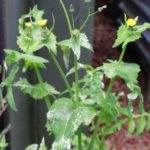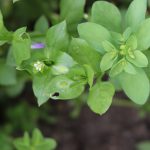Purslane – Portulaca oleracea
Description
 This has to be one of the least appreciated edible weeds with huge hidden benefits. It has 4mg per gram of Omega-3 fatty acid, compared to .89mg in spinach, so I had to include this gem. Purslane is a bit like a succulent with fleshy, hairless, rounded leaves growing on reddish, branched stems. It is an annual that spreads over the ground, only in summer and autumn and is killed by frost. It grows in dry waste places, gardens, farm gateways and yards and bare ground.
This has to be one of the least appreciated edible weeds with huge hidden benefits. It has 4mg per gram of Omega-3 fatty acid, compared to .89mg in spinach, so I had to include this gem. Purslane is a bit like a succulent with fleshy, hairless, rounded leaves growing on reddish, branched stems. It is an annual that spreads over the ground, only in summer and autumn and is killed by frost. It grows in dry waste places, gardens, farm gateways and yards and bare ground.
Nutritional qualities
Purslane has been used as a food and medicine for at least 2000 years. It is high time we rediscover this soothing, healing plant used for high blood pressure, anaemia, rickets, diabetes, blood disorders (its red stem is a clue that purslane is good for the blood) and fevers. It is a good source of thiamin, niacin, Vitamin B6 and folate, and a very good source of Vitamin A in the form of carotenes, Vitamin C, riboflavin, calcium, iron, magnesium, phosphorus, potassium, copper and manganese.
I recently made a new pesto using purslane. I included amaranth and sweet basil. It was very tasty.
Here is the recipe
 Purslane Weed Pesto
Purslane Weed Pesto
handful of purslane sprigs (stems and leaves washed)
3-4 sprigs amaranth with or without seed heads
sweet basil sprigs
2 sprigs galensoga
(can substitute NZ spinach or use more basil if you don’t have these weeds
3 cloves garlic
1/4 cup sunflower seeds
olive oil
1/4 tsp salt
Method
Process the sunflower seeds and add the garlic cloves.
Add the green leaves and pour on 2T olive oil and more if needed to make it moist and bind together.
Cashew Mayonnaise (from The Raw Chef Academy)
1 cup cashews
2 tablespoons lemon juice
1/2 teaspoon salt
2 tablespoons chopped onion
1/4 cup water
1/2 teaspoon agave nectar (I used honey)
Blend all ingredients in a high speed blender until smooth.
Slice cucumber, spread cashew mayo and then weed pesto on top as in the photo above.



